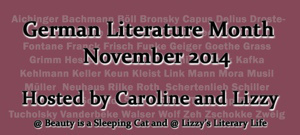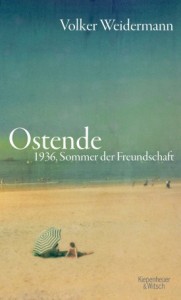This review is part of the German Literature Month, hosted by Lizzie (Lizzies Literary Life) and Caroline (Beauty is a Sleeping Cat)
The Belgian kings Leopold I and Leopold II liked to spend their summer holidays in the seaside town of Ostende, a place which was famous then and now for its long sandy beaches. What followed in the late 19th and early 20th century was a construction boom: the small harbor town developed into an opulent summer holiday location for the wealthy bourgeoisie and the upper echelons of society. Those who visit Ostende today will realize that a lot of the splendour of those days has gone and many of the gorgeous buildings of that time were destroyed either by the bombings of WWII or by the similarly devastating “modernization” frenzy in the 1950s and 1960s.
But in 1936, the old Ostende was still very much alive. Those who could afford it were packing their things and spending a few weeks here. Among them were also a group of German-language writers. They enjoy the sun, the swimming, the drinks, the company, and their talks about literature. But all of them either lost their homes, or had to prepare for losing it in the near future. They had mostly also lost their by far biggest publication market, Germany, and with it also the biggest part of their income. The small new book by Volker Weidermann, Ostende. 1936 – Sommer der Freundschaft (published this year and not yet translated) describes this summer, the strange atmosphere between holiday mood and depression that most of the writers felt. And it shows also the difficulties to be a writer in exile, and what happened to the friends that met in Ostende during that summer.
I was amazed to read who was in Ostende at exactly the same time – it reads like a part of the Who is who of German literature of that period: Stefan Zweig (with his secretary and lover Lotte Altmann); Joseph Roth; Irmgard Keun; Ernst Toller with his wife, the actress Christiane Grautoff; Egon Erwin Kisch, the famous “Raging Reporter from Prague” with his wife; Hermann Kesten; Arthur Koestler; also Willi Münzenberg, the “Red Press Czar” and founder of one of the biggest media empires of the world was there with his wife and some aides, among them the shady Otto Katz, one of the most notorious GPU agents, also known as Andre Simone.
Weidermann focuses the book mainly on the friendship between Stefan Zweig and Joseph Roth. Zweig, one of the few German-language writers that was not dependent from the German market because his books were popular almost all over the world, was in a similarly privileged position like Thomas Mann, Lion Feuchtwanger, or Erich Maria Remarque: they lived in very comfortable conditions even in exile, but all of them used their wealth and contacts to support the big number of poor colleagues financially or with contacts with publishers. In later years their assistance in getting affidavits and visas was crucial to get many writers out of Europa after the outbreak of the war (Anna Seghers’ Transit gives a haunting description of the emigrants in Marseille).
Joseph Roth was on the other side of the social pyramid of writers: the once well-paid journalist and author had not been very lucky. He was not the kind of person to save money for bad times to come and spent what he earned with full hands, living a life in the most expensive European hotels in the late 1920s and early 1930s. A mental illness of his wife who had to be admitted to an asylum (she was later killed by the Nazis in the framework of the infamous T4 program), his growing problems with alcohol – the book describes Zweig’s caring efforts to feed his friend at least one time or another – and his complete loss of the German and Austrian book market; there was hardly a disaster that didn’t strike Roth in those years. Stefan Zweig proved to be a loyal friend who helped Roth not only financially; he tried to make Roth quit or at least reduce his booze addiction; he discussed manuscripts with him and reminded him to work more slowly and diligently; and he introduced him to his other friends and colleagues in Ostende. Among them was a young and attractive “Aryan” female writer from Germany: Irmgard Keun.
Keun, already an accomplished writer in the early 30s, was caught in an unhappy marriage in Germany from which she ran away, and she had also difficulties to publish in Germany. Her books were banned and the works she wrote during her time in Belgium (for example After Midnight, her probably best book) and on travels would be published in German exile publishing houses. When she met Roth, it was obviously a coup de foudre from both sides. They started a relationship almost immediately after their first meeting, much to the surprise of the other emigrants who couldn’t understand what this attractive woman drew to the hopeless drunkard in tattered clothes. Weidermann describes how they got “to work”: they used to go to the same small bar every day, sit on separate tables with their small typewriters (Keun loved the sun, Roth couldn’t stand it) and ordered some liquor. Or more correctly: a lot of liquor. Yes, also Keun was an alcoholic. But for both of them, it seemed to have been an extremely productive time and both wrote excellent works during their time together.
Also for Zweig the times were not easy. But his were more his private problems and sorrows, not so much the political situation. His marriage with Friederike had failed, his home in Austria was soon to be sold to settle the financial issues following the divorce, and he had also sold his extraordinary collection of autographs. But his relationship with a young woman, Lotte Altmann, whom he hired as an assistant and secretary and who later became his mistress and after the divorce his second wife, also set new energies free in Zweig. He wanted to use the fresh energy he felt to do some serious work on some of his book projects in Ostende and also to think about where to settle in the future. It was also a good opportunity to catch up with friends and colleagues, especially with Joseph Roth with whom he entertained a close friendship.
For Zweig it was not the first time he came to Ostende. He had spent the summer 1914, the days before the outbreak of WWI in Ostende to meet his idol Emile Verhaeren. So overwhelmed was the young Zweig by the meeting with his master in 1914 that he didn’t realize at all that the world was preparing for war and that the world he loved would be doomed. (Verhaeren turned soon after the outbreak of the war into one of the most radical chauvinists, a major disappointment for Zweig)
What drew Zweig to Roth, and vice versa? For Zweig, Roth represented the Ostjudentum, the world of the Jews from the periphery of the Austro-Hungarian Empire, a world about which Zweig knew very little but to which he felt in a strange way attracted. And that Roth, despite his insane alcoholism and his financial dependency from Zweig, was so loyal and honest was for Zweig also very attractive. Roth knew no friendship, no superficial friendliness when it came to questions of literature. When he smelled one wrong expression, one superficial adjective, a weak plot, or something else that his unfailing instinct discovered, he would not hide it and let his friend know. Also vice versa, Roth accepted the professional advice of Zweig on many occasions. Due to the extreme difference in their living conditions one could have expected Roth to be a sycophant at least at times, but it seems that this was never the case. Theirs is a dialogue eye to eye when it came to matters of importance, i.e. to literature.
Weidermann’s book is excellently written. Not only writes he almost like an experienced novelist who arranges his material in an interesting way. He also succeeds in making the motives of his heroes understandable to the reader. And he adds interesting details that you can hardly read in any other book about the German exile – such as the unintentional act of disloyalty Zweig commits when he writes to his American publisher that Roth is suffering from being over-productive (writing too much in a short time) with the result that his exile books are much weaker than the previous one’s (I would disagree with Zweig here). As a result, the American publisher writes Roth that he is cancelling his author’s contract, a financial catastrophe for Roth who lives his last years mainly from Stefan Zweig’s financial support.
Although the other authors are not so much in the centre of the book, they play an important role too and Weidermann shows a great talent to integrate their fates almost effortlessly in his small masterpiece. Ernst Toller, the expressionist poet and dramatist, and his beautiful actress wife add a lot of flair to the weeks in Ostende – but Toller has always a rope with a noose in his suitcase; he suffers from extreme bouts of depression and the reader knows that he will sooner or later use the rope to hang himself. (When it finally happened a few years later, Roth collapsed when he heard the news and died shortly thereafter) Also the Münzenberg/Katz story made me shiver, knowing what later happened; and of course the end of the two main protagonists, so sad and unnecessary, victims of a time that was so opposed to the human values they represented in everything they did and wrote.
I hope for a swift translation of this wonderful book of Volker Weidermann. (The translation rights for the English-speaking edition are already sold to Pantheon/Knopf.) It will be a must for all Stefan Zweig and Joseph Roth aficionados, and for all friends of literature in general. And if you visit Ostende, take this book with you. And don’t miss the house of the painter James Ensor. It plays a small but important role in this book too and is different from any other house you will ever visit.
Volker Weidermann: Ostende. 1936, Sommer der Freundschaft, Kiepenheuer & Witsch, Köln 2014
© Thomas Hübner and mytwostotinki.com, 2014. Unauthorized use and/or duplication of this material without expressed and written permission from this blog’s author and/or owner is strictly prohibited. Excerpts and links may be used, provided that full and clear credit is given to Thomas Hübner and mytwostotinki.com with appropriate and specific direction to the original content.





 Facebook
Facebook RSS
RSS Twitter
Twitter